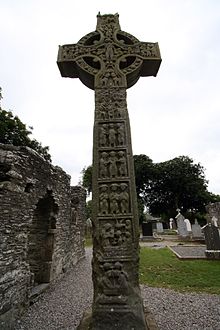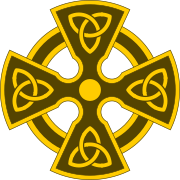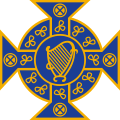Celtic cross


The Celtic cross is a form of Christian cross featuring a nimbus or ring that emerged in Ireland, France and Great Britain in the Early Middle Ages. A type of ringed cross, it became widespread through its use in the stone high crosses erected across the islands, especially in regions evangelized by Irish missionaries, from the ninth through the 12th centuries.

A staple of Insular art, the Celtic cross is essentially a Latin cross with a nimbus surrounding the intersection of the arms and stem. Scholars have debated its exact origins, but it is related to earlier crosses featuring rings. The form gained new popularity during the Celtic Revival of the 19th century; the name "Celtic cross" is a convention dating from that time. The shape, usually decorated with interlace and other motifs from Insular art, became popular for funerary monuments and other uses, and has remained so, spreading well beyond Ireland.
Early history


It is not clear where the first high crosses originated. The first examples date to about the ninth century and occur in two groups: at Ahenny in Ireland, and at Iona, an Irish monastery off the Scottish coast. The Ahenny group is generally earlier. However, it is possible that St. Johns Cross at Iona was the first high cross; Iona's influence as a center of pilgrimage may have led this cross to inspire the Ahenny group as well as other ringed crosses in Pictish stones.[3]
A variety of crosses bear inscriptions in
Popular legend in Ireland says that the Christian cross was introduced by Saint Patrick or possibly Saint Declan, though there are no examples from this early period. It has often been claimed that Patrick combined the symbol of Christianity with the sun cross to give pagan followers an idea of the importance of the cross. By linking it with the idea of the life-giving properties of the sun, these two ideas were linked to appeal to pagans. Other interpretations claim that placing the cross on top of the circle represents Christ's supremacy over the pagan sun.
- Notable high crosses with the Celtic shape in Ireland
- Ahenny, County Tipperary
- Ardboe County Tyrone
- Carndonagh, County Donegal
- Drumcliff, County Sligo
- Dysert O'Dea Monastery, County Clare
- Glendalough County Wicklow St. Kevin's Cross
- Killamery, County Kilkenny
- Kloster Fahan Fahan, County Donegal
- Monasterboice, County Louth
- Clonmacnoise Cross of the Scriptures, County Offaly
- Clonmacnoise North Cross, County Offaly
- Clonmacnoise South Cross, County Offaly
- Kells, County Meath
- Moone, County Kildare
- Notable high crosses with the Celtic shape in Scotland
- Campbeltown Cross
- Iona Abbey Crosses
- Inchbraoch Cross
- Kildalton Cross
- Massacre of Glencoe Monument
- Meigle 1 Cross
- St. Martin's Cross at Iona Abbey
- St Gordian's Kirk Cross
- Govan Old Parish Church Cross
- Weem, Aberfeldy
- Notable Celtic crosses in India
- Mateer Memorial Church, Kerala, India
Modern times
Celtic Revival
The Celtic Revival of the mid-19th century led to an increased use and creation of Celtic crosses in Ireland. In 1853, casts of several historical high crosses were exhibited at the Dublin Industrial Exhibition. In 1857, Henry O'Neill published Illustrations of the Most Interesting of the Sculptured Crosses of Ancient Ireland. These two events stimulated interest in the Celtic cross as a symbol for a renewed sense of heritage within Ireland.
New versions of the high cross were designed for fashionable cemetery monuments in Victorian Dublin in the 1860s. From Dublin, the revival spread to the rest of the country and beyond. Since the Celtic Revival, the ringed cross became an emblem of Celtic identity, in addition to its more traditional religious symbolism.[6]
Modern interest in the symbol increased because of Alexander and Euphemia Ritchie. The two worked on the island of Iona in Scotland from 1899 to 1940 and popularised use of the Celtic cross in jewelry.[7] Using the Celtic cross in fashion is still popular today.
-
Ornamental Celtic cross withCeltic knots
-
Decorative Celtic cross with triquetras
-
Celtic cross with triquetras
-
USVA headstone emblem 41
-
USVA headstone emblem 46
Since its revival in the 1850s, the Celtic cross has been used extensively as grave markers, straying from medieval usage, when the symbol was typically used for a public monument. The Celtic cross now appears in various retail items. Both the Gaelic Athletic Association and the Northern Ireland national football team have used versions of the Celtic cross in their logos and advertising. The Church in Wales since 1954 have used a flag with a Celtic cross in the centre.

A Celtic cross is often used to represent Presbyterianism, including by the US Department of Veterans Affairs.
-
Modern Celtic cross of a war monument in Limburg-Dietkirchen, Germany
-
Modern Celtic cross atCimetière du Père-Lachaise, Paris
-
Original crest of the Irish Football Association
-
Flag of the Isle of Skye
White supremacist symbolism

A version of the Celtic cross is used as a symbol by
It is suggested that adoption of the symbol in the context of right-wing politics is linked with the activity of Jesuit priest Paul Doncœur, a prominent figure of the interwar scout movement in France.[10][11] In 1924, the victory of anti-clerical Cartel des Gauches in general elections caused the mobilisation of right-wing forces, with Doncœur playing a major role in formation of Fédération Nationale Catholique[12] and Ligue DRAC.[13] The same year, impressed by Quickborn, a Catholic organisation within the German Youth Movement, he founded its local equivalent, Cadets.[14][15] Doncœur, inspired by the G. K. Chesterton's novel The Ball and the Cross, decided that the symbol of the movement, croix cadet, should consist of a circle, representing the material world, supported by a square Christian cross intersecting it.[16][17][18]
After the Fall of France, Vichy government relied on pre-existing organisations to implement its youth policy according to the principles of the National Revolution. The field was dominated by Catholic scout movements, the leaders of which were put in charge of Secretariat-General of Youth.[10][19][20][21][22] In 1941, the symbol of Doncœur, now named croix celtique, was adopted as an emblem for Cadets of the Légion in Algeria, a youth movement within Légion Française des Combattants,[11][23] a veteran organisation which the government hoped could be transformed to function as the single party of the state.[20][24] Then it was used as insignia of Equipes nationales, a youth civilian service institution founded in 1942.[11][14][19] After the war, Pierre Sidos appropriated the symbol as an emblem of the far-right movement Jeune Nation, founded by him in 1949.[25]
White supremacist use of the long and short Celtic cross represents only a small minority of the symbol's use.[9] The symbol in both forms is used by non-extremists in contexts such as Christianity, neo-Paganism,[8] and Irish patriotism. The vast majority of uses of the Celtic cross are not associated with white supremacists.[9]
-
A Celtic Cross Flag used by White Supremacists
-
Neo-nazi Celtic cross flag
-
White Pride World Wide symbol, logo of Stormfront
-
National-anarchist star
Unicode
In Unicode, the Celtic cross is represented by the code point U+1F548 🕈 CELTIC CROSS.
See also
References
- ^ Herren & Brown 2002, pp. 193–195.
- ^ Herren & Brown 2002, p. 199.
- ^ S2CID 192024681.
- ^ Herren & Brown 2002, pp. 199–200.
- OCLC 1008359745.
- ^ Stephen Walker, "Celtic Revival Crosses" Archived 1 October 2016 at the Wayback Machine, Celtic Arts website, accessed 22 November 2008
- ^ "A Brief History of the Ritchies", Alexander Ritchie website, accessed 20 Nov 208
- ^ a b "A Look at Racist Skinhead Symbols and Tattoos". Southern Poverty Law Center. Retrieved 31 May 2020.
- ^ a b c "Celtic Cross". Anti-Defamation League. Retrieved 31 May 2020.
- ^ ISBN 978-0-7735-0973-3.
- ^ ISBN 978-2-86714-380-9.
- ISBN 978-0-271-09083-2.
- .
- ^ ISBN 978-2-204-02318-4.
- .
- ^ Doncoeur, Paul (1924). Cadets. Paris: l'Art catholique.
- ISBN 978-2-204-06562-7.
- ^ Avon, Dominique (1998). "Péguy, un maître du Père Doncoeur et de ses Cadets". L'Amitié Charles Péguy. Lectures poétiques et mystiques de l'øeuvre de Péguy (84): 211–228.
- ^ ISBN 978-2-262-00800-0.
- ^ ISBN 9780198207061.
- ISBN 978-0-7391-1146-8.
- ^ Lackerstein, Debbie (2007). National regeneration in Vichy France: the appeals to renewal and sirens of decline (PhD thesis).
- ^ Cadet et cadettes de la Légion: mouvement de jeunesse d'action civique et sociale / Jeunesse légionnaire d'Algérie (in French). Légion française des combattants Union provinciale (Algérie).
- ISBN 9782738110572.
- ^ "Entretien: Pierre Sidos". Revue Charles (in French). 12 April 2013. Retrieved 4 September 2023.
Bibliography
- Herren, Michael W.; Brown, Shirley Ann (2002). Christ in Celtic Christianity: Britain and Ireland from the Fifth to the Tenth Century. Boydell Press. ISBN 978-0-85115-889-1.
- H. Richardson: An introduction to Irish high crosses. 1990, ISBN 0-85342-941-3.
- ISBN 0-7661-9262-8.
- Peter Harbison: The high crosses of Ireland. Habelt, Bonn, 3 Baende, 1991.
External links
 Media related to Celtic crosses at Wikimedia Commons
Media related to Celtic crosses at Wikimedia Commons- David Dimbleby. "Age of Conquest". Seven Ages of Britain. 29:16 minutes in. BBC 1.

















